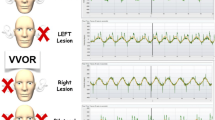Abstract
While there is agreement that unilateral vestibular deafferentation (UVD) invariably produces an immediate severe horizontal vestibulo-ocular reflex (HVOR) deficit, there is disagreement about whether or not this deficit recovers and, if so, whether it recovers fully or only partly. We suspected that this disagreement might mainly be due to experimental factors, such as the species studied, the means chosen to carry out the UVD, or the nature of the test stimulus used. Our aim was to sort out some of these factors. To do this, we studied the HVOR of alert guinea pigs in response to low and high acceleration sinusoidal and high acceleration impulses after UVD by either labyrinthectomy or by vestibular neurectomy. The HVOR in response to high acceleration impulsive yaw rotations was measured before, and at various times after, either unilateral labyrinthectomy or superior vestibular neurectomy. Following UVD, there was a severe impairment of the HVOR for ipsilesional rotations and a slight impairment for contralesional rotations, after either operation. This asymmetrical HVOR deficit in the guinea pig parallels the deficit observed in humans. Between the first measurement, which was made 1 week after UVD, and the last, which was made 3 months after UVD, there was no change in the HVOR. This lack of recovery was the same after labyrinthectomy as after vestibular neurectomy. The HVOR to low and high acceleration sinusoidal yaw rotations were measured after UVD, and the results were compared with those in response to impulsive rotations. For low acceleration sinusoidal rotations (250°/s2), the gain was symmetrical, although reduced bilaterally. As the peak head acceleration increased, the HVOR became increasingly asymmetric. The HVOR asymmetry for sinusoidal rotations was significantly less than for impulsive rotations that had the same high peak head acceleration (2500°/s2). Our results show that the HVOR deficit after UVD is the same in guinea pigs as in humans; that it is the same after vestibular neurectomy as after labyrinthectomy; that it is lasting and severe in response to high acceleration rotations; and, that it is more obvious in response to impulses than to sinusoids.
Similar content being viewed by others
Author information
Authors and Affiliations
Additional information
Received: 11 March 1998 / Accepted: 2 June 1998
Rights and permissions
About this article
Cite this article
Gilchrist, D., Curthoys, I., Cartwright, A. et al. High acceleration impulsive rotations reveal severe long-term deficits of the horizontal vestibulo-ocular reflex in the guinea pig. Exp Brain Res 123, 242–254 (1998). https://doi.org/10.1007/s002210050566
Issue Date:
DOI: https://doi.org/10.1007/s002210050566




